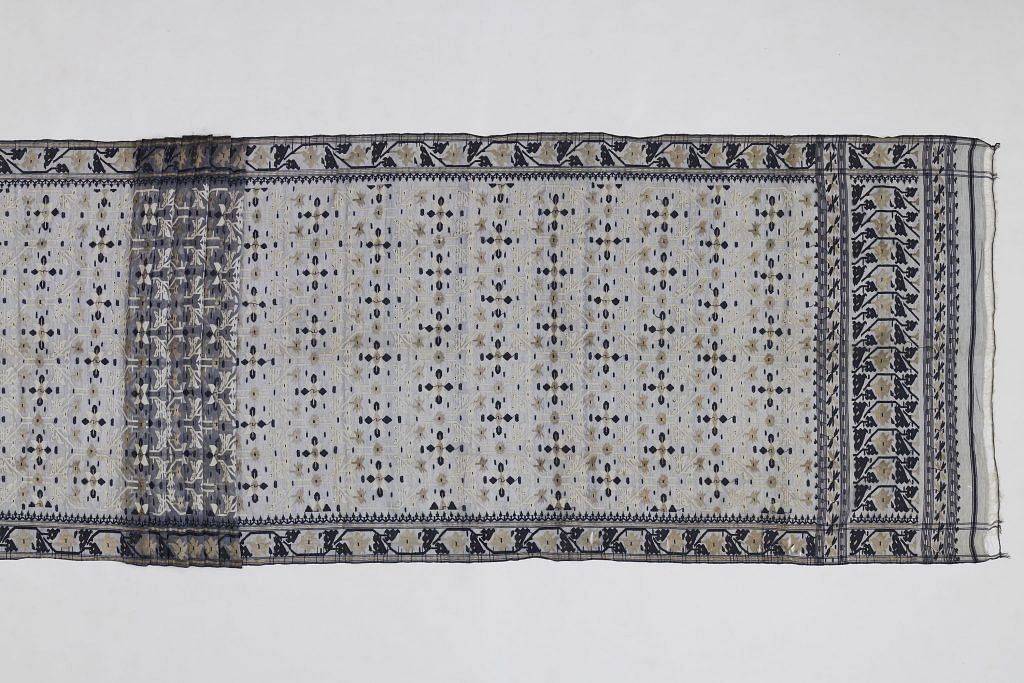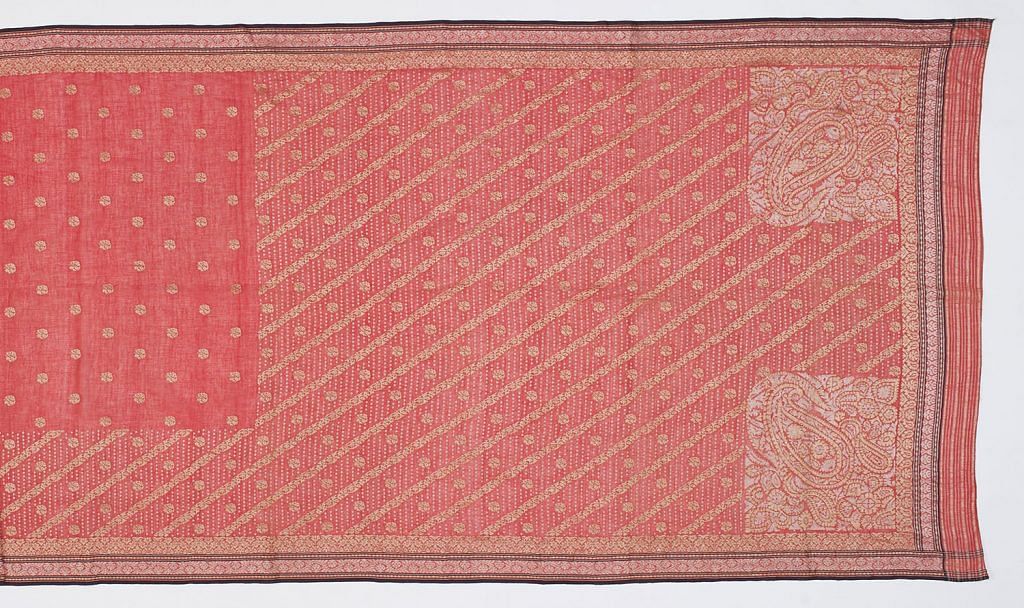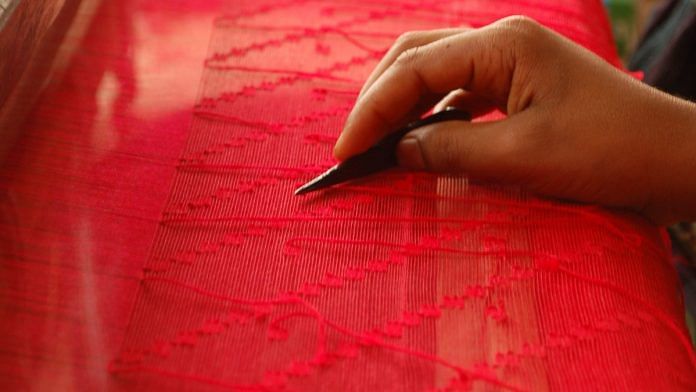A cotton brocade characterised by floral patterns, jamdani is a light and translucent fabric. While the etymology is uncertain, the name may have been derived from the Persian jama, meaning robe or garment, and dan, meaning container.
Jamdani weaving is believed to have emerged from the Dhaka muslin industry, with both plain and decorative motifs emerging during the reign of Muhammad bin Tughlaq (1324–51), with the arrival of Persian craftsmen to India. However, the fabric can be dated to the writings of Megasthenes, the Greek ambassador at Chandragupta Maurya’s court, as well as the Arthashastra by Kautilya, in 300 BCE.
The quality of jamdani weaving developed further with sustained patronage from the Mughals, resulting in the use of translucent, locally woven muslin with thread counts of over 250. Jamdani appealed particularly to Muslim men, who were not permitted to wear silk according to religious law, and so sought out similarly light textiles and fabric. Traditionally, Hindu craftspeople were engaged in yarn spinning and weaving plain muslin, whereas Muslim weavers constituted the majority of jamdani weavers and were referred to as jamdani tantis or julahas.
Also Read: ‘Grow indigo in 3 kathas of each bigha’ – How the British forced Indians into debt, starvation
The migration of weavers and craftspeople, who moved along with their royal patrons, also resulted in the adoption of jamdani weaving techniques in other parts of the subcontinent, resulting in varieties such as the Uppada jamdani and Tangail jamdani. The white-on-white jamdani woven in Tanda, Uttar Pradesh, is believed to have been established under the patronage of Nawab Wajid Ali Shah (1847–56) of the kingdom of Awadh. The seventeenth century also saw the development of Uppada jamdani sarees in Andhra Pradesh, which were woven exclusively for the royal families of Pithapuram, Bobilli and Venkatagiri. Over 80 percent of the weavers involved in making Uppada jamdani today are women.

The fabric is woven using fine cotton yarn, with the patterns inserted by hand through extra-weft weaving using either a shuttle or a needle. The cotton yarn is processed and dyed before being sized and strengthened by applying rice starch from Kalma rice to the yarn. The sized yarn is transferred onto spools and bobbins to be used as the warp and weft. While the ground yarn of jamdani is made using fine cotton threads, the supplementary weft designs are made using thicker threads. While, traditionally, jamdani was woven only using cotton yarn, contemporary variations on the cloth incorporate other materials such as nylon, a mix of silk and cotton and pure silk.
Both men and women are equally involved in the pre-weaving and readying of the yarn. Today, weaving is done on a jacquard loom, which allows for intricate designs to be transferred to the cloth using punch cards. Two weavers work side by side on the loom, counting and flicking the design thread from its individual spool across the width of the fabric using the kandi. The weaving of mul mul jamdani often requires a third weaver.
After the design threads are fixed by the weavers, the shuttle is thrown across the width of the cloth, drawing the warp threads to a close. This process is repeated for every row to render the final woven product. The floral designs are rendered by hand through a discontinuous supplementary weft using a tool called kandul, where the weft is interlaced with the warp in zigzag patterns from an individual spool of thread using fine bamboo or metal sticks.
Jamdani weaving uses a wide range of colour palettes. Contemporary jamdani features a base of naturally coloured or unbleached cotton with bleached white cotton designs; a pastel-coloured base with supplementary work in white; a dark base in colours such as dark blue, dark red or black, with the design in coloured threads; and a coloured base with the designs rendered using zari and cotton threads. The designs on jamdani could be rendered in a variety of patterns, primarily scattered floral designs throughout the fabric, known as butidar; a network of patterns across the cloth, known as jhalar or jala; or with the designs placed in linear diagonals, called terchi. Common motifs on jamdani include pati (petal), bagher paa (tiger’s paw), sandesh (sweets), ashrafi (gold coin), kainchi (scissors), panna hajar (thousand emeralds), kalaka (paisley), tesra (diagonal patterns), duria (polka dots), charkona (rectangular motifs) and other fruits, flowers and animals.

By the early eighteenth century, the muslin industry in the country had essentially come to a halt and was further adversely impacted by Partition in 1947, with the focus shifting to the khadi industry. The colonial cultivation of cotton also shifted from Dhaka to Egypt and America, which impacted cotton cultivation in the region. The imported cotton was coarser and difficult to work with compared to fine muslin, resulting in less intricate motifs. Jamdani eventually became the only surviving form of cotton weaving in the region. Further, with the industrial revolution in England, the Indian subcontinent became an important market for cheap, British-made imitation fabric, which compromised the quality of the jamdani available in the region.
Also Read: Drumstick tea & chickpea ‘pasta’: Indian staples are now Western superfoods
After Partition, weavers from Bangladesh, particularly Tangail, migrated to West Bengal and settled in Kalna and Nadia, about hundred kilometres from Kolkata, where they developed the khadi-muslin industry, which recreated super fine thread for a 500-count yarn. By the twentieth century, Sonargaon had emerged as an important centre of jamdani weaving, and the textile became the preferred fabric for weaving sarees worn by women in the Bengal region.
Today, the districts of Nadia and Bardhman in West Bengal, as well as Sonargaon and Rupshi in Bangladesh, are renowned for their jamdani industries. The Debnath family from Kalna, consisting of master weaver Jyotish Debnath and his son Rajib, specialise in making fine muslin jamdani using only hand-spun cotton, with the designs inserted using a fine needle in place of a shuttle. Additionally, master weaver Biren Basak from Nadia specialises in weaving narrative scenes using the jamdani technique. The Weavers Service Centre in Vijayawada was instrumental in reviving the Uppada jamdani technique when it was on the brink of extinction in the 1980s. Jamdani weavers today continue to follow traditional techniques and methods of muslin-making to retain the quality and authenticity of jamdani. However, a contemporary 46-inch-wide jamdani saree contains a maximum of 1,900 threads, as opposed to earlier varieties which would have thread counts of about 2,800 for a width of 40 inches.
In 2013, UNESCO added jamdani weaving to the Representative List of the Intangible Cultural Heritage of Humanity. The fabric also received the Geographical Indications (GI) tag in Bangladesh in 2016. Jamdani enjoys widespread popularity today, and samples of the fabric are housed in museums across the world, including at the Philadelphia Museum of Art; the National Museums Liverpool; the Cooper-Hewitt, Smithsonian Design Museum, New York; and the Victoria & Albert Museum (V&A), London.
This excerpt is taken from MAP Academy’s ‘Encyclopedia of Art’ with permission.
The MAP Academy is a non-profit, online platform — consisting of an Encyclopedia, Courses and a Blog — which encourages knowledge building and engagement with the visual arts of the region.



